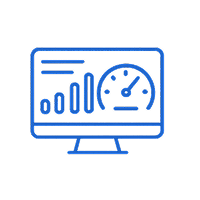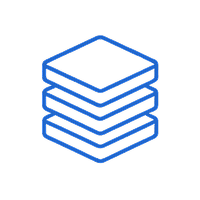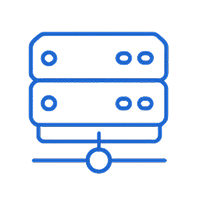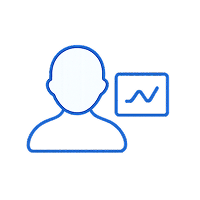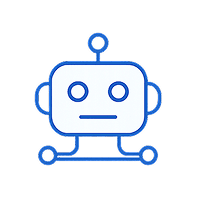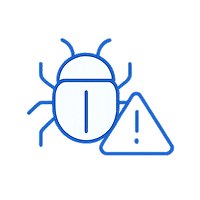SigNoz is an open-source, OpenTelemetry-native observability platform designed to give engineering teams full transparency, self-hosting flexibility, and a modern MELT stack powered by ClickHouse for fast analytics. However, the operational overhead of managing ClickHouse, tuning storage usage, and maintaining the observability stack can become burdensome.
CubeAPM solves these challenges by offering an OpenTelemetry-native backend with predictable ingestion pricing, no heavy database maintenance, and a polished, unified MELT experience. It delivers deep application insights without the operational burden of managing the storage layer.
In this article, we’ll break down the top 7 SigNoz alternatives across these categories, starting with CubeAPM, and including leading observability platforms like Coralogix, Grafana, New Relic, and Dynatrace.
Top 7 SigNoz Alternatives
- CubeAPM
- Coralogix
- Datadog
- Dynatrace
- New Relic
- Sumo Logic
- Better Stack
APM Tools Comparison: SigNoz vs CubeAPM vs Others (2025)
| Tool | *Pricing(Small, Mid, Large) | Native OTEL | Support TAT | Deployment Option |
| CubeAPM | Small: $2,080 Mid: $7,200 Large: $15,200 | Yes | Within minutes | Self-hosted |
| SigNoz | Small: $4,600 Mid: $16,000 Large: $34,000 | Yes | Not available | SaaS and Self-hosted |
| New Relic | Small: $7,896 Mid: $25,990 Large: $57,970 | *No | 2hrs to days | SaaS only |
| Datadog | Small: $8,185 Mid: $27,475 Large: $59,050 | *No | <2hrs-48hrs | SaaS only |
| Dynatrace | Small: $7,740 Mid: $21,850 Large: $46,000 | *No | 4hrs to days | SaaS and Self-hosted |
| Sumo Logic | Small: $16,300 Mid: $42,000 Large: $103,250 | *No | 1hr to 1day | SaaS only |
| Coralogix | Small: $4,090 Mid: $13,200 Large: $29,000 | Yes | Within minutes | SaaS only |
| Better Stack | Small: $5,723 Mid: $20,550 Large: $43,350 | *No | Within hours | SaaS only |
*All pricing comparisons are calculated using standardized Small/Medium/Large team profiles defined in our internal benchmarking sheet, based on fixed log, metrics, trace, and retention assumptions. Actual pricing may vary by usage, region, and plan structure. Please confirm current pricing with each vendor.
*OTEL Sources: Datadog uses proprietary SDKs; Dynatrace uses collectors; Splunk AppDynamics uses collectors; Sumo Logic uses collectors, Better Stack uses collectors.
Why Look for SigNoz Alternatives?
SigNoz has emerged as a strong open-source observability platform with native OpenTelemetry support, making it a compelling option for engineering teams focused on modern, self-hosted telemetry pipelines. It covers core MELT functionality (Metrics, Events, Logs, Traces), supports ClickHouse-based storage, and integrates well with Kubernetes-native environments. However, as companies grow and push more production workloads through their observability stack, several limitations of SigNoz become apparent — prompting many to consider mature alternatives.
1. ClickHouse Memory Challenges
As your data volume grows, managing ClickHouse becomes increasingly demanding. You may find yourself constantly tuning memory usage, adjusting retention rules, and troubleshooting performance issues — all of which take time away from debugging your actual applications.
2. Increasing Operational Complexity
The combined SigNoz + ClickHouse stack introduces real maintenance overhead. Scaling nodes, handling upgrades, managing storage, and ensuring query performance can feel like a second job, especially for teams without dedicated DevOps resources.
3. UI Feels Functional but Unrefined
While the interface works, it can feel rigid or clunky during daily use. Navigating dashboards, searching logs, or drilling into traces often requires extra steps, making routine troubleshooting slower than it should be.
4. Steep Learning Curve
While SigNoz is flexible and scriptable, extracting full value requires understanding ClickHouse tuning, OTEL enrichment pipelines, and YAML-based configurations. Teams without dedicated observability engineers may struggle to optimize retention, performance, and alerting without extensive trial and error.
Criteria for Suggesting SigNoz Alternatives

Source link: Reddit
1. Operational Simplicity and Production Stability
While SigNoz offers basic Helm/Docker setup, running it in production requires hands-on maintenance of ClickHouse, and alert pipelines. Tools that abstract this complexity or offer turnkey SaaS with optimized storage pipelines help teams avoid out-of-memory issues, dashboard lag, and ingestion failures during scale.
2. Transparent and Predictable Pricing
SigNoz shifts the cost to infrastructure, which makes pricing unpredictable — especially as ingestion grows. Better alternatives provide flat-rate pricing models based on actual usage (e.g., $/GB), with no surprise costs from over-provisioning, query loads, or high-cardinality data.
3. Ease of Deployment and Operational Overhead
If managing ClickHouse, scaling nodes, and maintaining infrastructure has become a burden, look for alternatives that reduce operational complexity. Tools like CubeAPM offer lightweight, OTel-native ingestion with minimal backend maintenance, while SaaS platforms like Datadog and New Relic remove hosting responsibilities entirely.
4. Enterprise Security, Governance, and Compliance Needs
Large organizations may require SSO, RBAC, audit logs, data residency controls, or compliance certifications. Managed alternatives like Datadog and Dynatrace offer mature enterprise features, while CubeAPM provides self-hosted options for full data control.
SigNoz Overview

Known for
Open-source, OpenTelemetry-native observability with support for metrics, traces, logs, and events. Popular among developers for its modern UI, self-hosting flexibility, and tight integration with ClickHouse.
Key Features
- OpenTelemetry-Native Instrumentation: Built with OpenTelemetry at its core, SigNoz supports standardized telemetry ingestion without vendor lock-in. It works with OTEL SDKs and supports Prometheus exporters for metrics.
- Traces, Metrics, Logs, Events – MELT Coverage: Signoz supports core MELT components including distributed tracing, log search and filtering, infrastructure metrics, and events for alerting
- Self-Hosted or Cloud Deployment: SigNoz can be deployed via Docker or Helm charts, making it accessible for engineering teams comfortable with Kubernetes. Cloud-hosted plans are available for teams wanting to avoid infra overhead.
- Open UI and Dashboards: Offers prebuilt dashboards and service maps for tracing, along with Prometheus-style metric panels. Allows querying via clickhouse-like syntax.
Standout Features
- Open-source transparency with GitHub-based development
- ClickHouse-backed storage for fast analytical queries
- Single-pane interface for traces, logs, and metrics
- Slack & community support with decent documentation
- Tail-based sampling support via OpenTelemetry pipeline
Pros
- OpenTelemetry-native and vendor-neutral
- Strong community momentum (20K+ GitHub stars)
- Flexible self-hosting and Helm install options
- Query everything through unified dashboard
- Cloud offering available for faster onboarding
Cons
- Managing ClickHouse memory usage is time-consuming
- Operational complexity, especially for managing the stacks
- The UI, while functional, might feel cluttered
Best For
- Dev teams wanting open-source, OTEL-native observability
- Startups and mid-market orgs exploring APM without vendor lock-in
- Engineering orgs already managing ClickHouse or Kafka clusters
Pricing & Customer Reviews
- Self-hosted: Free
- For SigNoz SaaS:
- Logs: $0.3/GB ingested
- Traces: $0.3/GB ingested
- Metrics: $0.1/mil samples
- G2 Rating: 4.5 / 5
- Praised for: Simplicity, UI, open-source approach
- Criticized for: complexity, especially in backend management
Top 7 SigNoz Alternatives
1. CubeAPM

Known for
A full-stack, OpenTelemetry-native APM platform focused on cost efficiency, Smart Sampling, compliance-ready hosting, and blazing-fast ingestion speeds. CubeAPM is ideal for DevOps and SRE teams who want reliable observability without overpaying or compromising on control.
Key Features
- Full MELT Support: CubeAPM supports Metrics, Events, Logs, and Traces natively, along with Real User Monitoring (RUM), synthetics, and error tracking—all in one unified platform.
- Smart Sampling: Unlike SigNoz, which stores all traces unless filtered manually, CubeAPM uses context-aware Smart Sampling to prioritize high-value telemetry (e.g. slow or erroring traces) and reduce noise, improving cost and visibility.
- 1-Hour Setup & Agent Compatibility: Supports drop-in agents from Datadog, Prometheus, OpenTelemetry, and New Relic, making migration seamless with prebuilt dashboards and auto-instrumentation.
Standout Features
- $0.15/GB data ingestion pricing—no hidden user or host fees
- AI-powered Smart Sampling for intelligent trace filtering
- Real-time Slack support directly with engineers
- Prebuilt AWS/Kubernetes dashboards with full support for EC2, EKS, Lambda, RDS, and more
- Self-hosting and cloud-hosting flexibility
Pros
- Full-stack observability with OTEL-native ingestion
- Cost predictability with flat-rate pricing
- 2–4x faster ingestion performance
- Ideal for data localization and compliance use cases
- Works out of the box for AWS, K8s, Redis, Kafka, etc.
Cons
- Not suited for teams looking for off-prem solutions
- Strictly an observability platform and does not support cloud security management
Best For
- Engineering orgs seeking lower cost and control over telemetry
- Startups and mid-sized teams are scaling fast, but watching budgets
Pricing & Customer Reviews
- Pricing: $0.15/GB flat ingestion rate
- Rating: 4.7 / 5(based on pilot programs, Slack feedback, and demos)
- Praised for: Developer-friendly UX, transparent pricing, and powerful trace sampling
- Criticized for: Currently growing ecosystem (fewer marketplace plugins vs. Datadog)
CubeAPM vs SigNoz
While SigNoz provides a free self-hosted OTEL-first experience, CubeAPM goes beyond with Smart Sampling, full MELT coverage, data localization, and no operational burden. It also avoids ClickHouse-related overhead and supports flexible deployment—making it more production-ready and scalable for modern teams.
2. Dynatrace
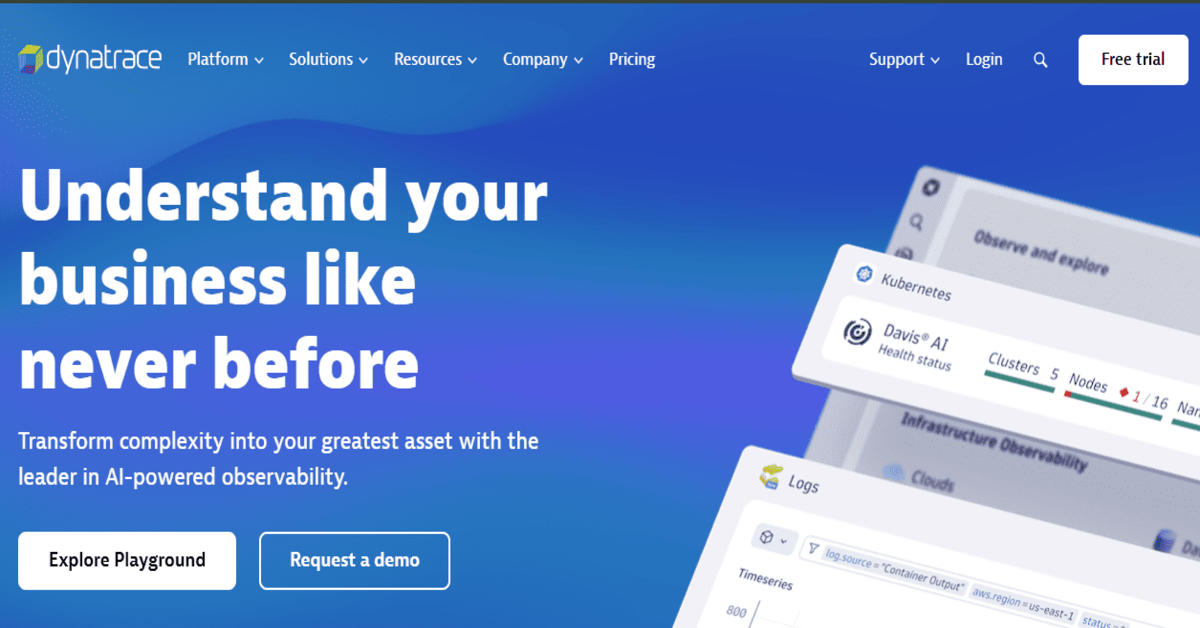
Known For
An AI-powered enterprise observability platform with deep-rooted infrastructure monitoring, application security, and real-time analytics. Dynatrace is known for its full-stack automation and Davis AI engine, making it a favorite for large enterprises with complex microservices and cloud-native workloads.
Key Features
- Davis AI Engine: Dynatrace uses a proprietary AI engine to detect anomalies, reduce alert fatigue, and auto-discover root causes in highly dynamic environments.
- OneAgent Deployment: Single-agent deployment auto-discovers all services and dependencies, reducing manual configuration across containers, hosts, and serverless workloads.
- Security + Observability: In addition to APM and infra monitoring, Dynatrace offers runtime application protection (RASP) and vulnerability analytics, combining observability with security insights.
- Cloud Automation: Strong integration with AWS, Azure, GCP, and Kubernetes for intelligent workload placement and auto-scaling recommendations.
Standout Features
- AI-driven anomaly detection and root cause automation
- Auto-instrumentation via OneAgent
- Built-in digital experience monitoring and session replay
- Observability + security in one pane of glass
- High granularity for distributed architectures
Pros
- Enterprise-grade scalability and resilience
- No sampling; captures 100% of transactions
- Powerful AI analytics and auto-baselining
- End-to-end visibility across infra, app, user, and cloud
Cons
- Very expensive, with pricing complexity across host units, and log quotas
- Steep learning curve for new users
- UI can feel cluttered
Best For
- Large enterprises with high observability maturity
- Teams running massive multi-cloud microservices
- Enterprises that want observability + application security in one platform
Pricing & Customer Reviews
- Full-Stack Monitoring: $58 /month/8 GiB host
- Infra Monitoring: $29/month/8 GiB host
- G2 Rating: 4.5 / 5
- Praised for: Automation, AI capabilities, breadth of coverage
- Criticized for: High cost, complexity, and overwhelming interface
Dynatrace vs SigNoz
While SigNoz is better suited for teams starting with open-source observability, Dynatrace is purpose-built for large, high-volume environments that require AI-backed root cause analysis, auto-instrumentation, and enterprise governance. However, SigNoz has the advantage in simplicity, cost, and flexibility for early-stage teams.
3. Coralogix
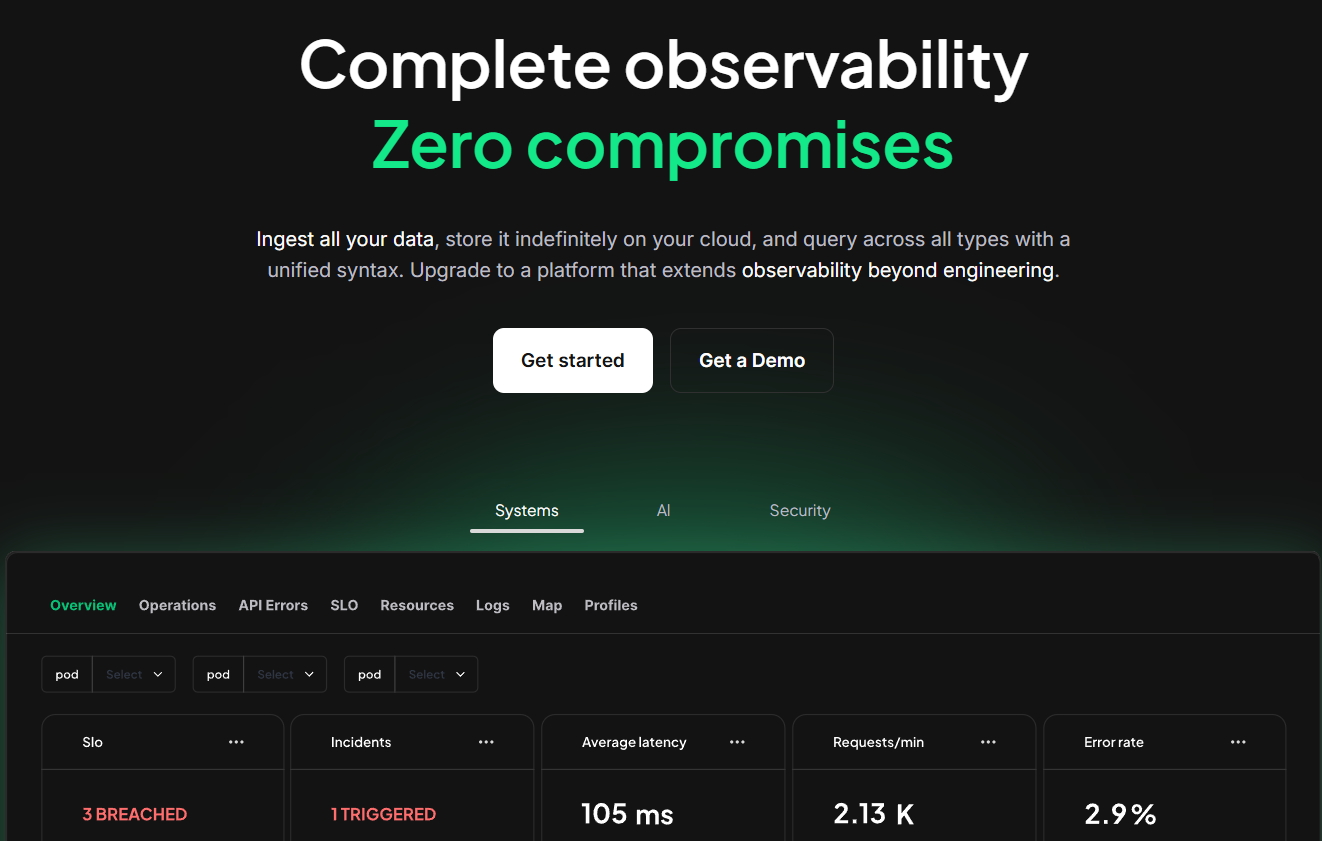
Known For
A log-first observability platform designed for DevSecOps teams managing high-volume telemetry. Coralogix focuses on real-time stream processing, modular indexing, and pipeline-level control to reduce ingestion and storage costs.
Key Features
- Streama™ Architecture: Lets you ingest data without indexing everything. You can route logs directly to cold storage (like S3) and still query them when needed, reducing active storage cost.
- Archive in Customer Cloud: Archived telemetry is stored in your own cloud account, making long-term storage cheaper. However, it introduces egress fees and compliance concerns, as data first flows through Coralogix.
- Ingestion Control & Parsing: Granular log routing, parsing, and enrichment tools allow teams to control which logs are indexed vs streamed or archived—helping manage cost spikes.
- OpenTelemetry Support: Supports OTEL ingestion, but requires manual enrichment and routing to unify context across traces, logs, and metrics.
Standout Features
- Smart ingestion tiering to reduce indexing/storage costs
- Route unindexed logs to your cloud via S3
- Dashboards for infrastructure, apps, and business KPIs
- Support for logs, metrics, traces (MELT) with OTEL
- SOC2, HIPAA, and GDPR-compliant deployments
Pros
- Advanced cost optimization through log routing
- Flexible pipeline configuration via Streama™
- Suitable for large log volumes and retention use cases
- Good for teams with mature log parsing needs
Cons
- Pricing can rise quickly with scale
- UI can feel unintuitive or difficult to navigate
- Steeper learning curve for advanced features
Best For
- Teams with log-heavy observability needs
- Engineering orgs that want archival control and cost management
- Enterprises dealing with cold log storage and audit retention
Pricing & Customer Reviews:
- Logs: $0.42/GB
- Traces: $0.16/GB
- Metrics: $0.05/GB
- AI: $1.5/1M tokens
- G2 Rating: 4.6 / 5
- Praised for: Log control, Streama™ design, ingestion flexibility
- Criticized for: steep learning curve, high costs at scale
Coralogix vs SigNoz
While both tools support OpenTelemetry and cost control, SigNoz offers unified MELT observability in a more straightforward open-source format. Coralogix, while more mature in log routing, requires deeper configuration and introduces egress costs. However, SigNoz lacks the archival flexibility that Coralogix offers.
4. New Relic

Known For
New Relic is a well-established, full-stack observability platform that provides telemetry collection, analysis, and visualization across the MELT stack. New Relic is known for its all-in-one UI, instrumentation libraries, and usage-based pricing model, making it accessible but potentially expensive at scale.
Key Features
- All-in-One Telemetry Platform: New Relic supports metrics, events, logs, and traces (MELT) in a unified UI called New Relic One. It includes dashboards, anomaly detection, service maps, and code-level insights.
- Auto Instrumentation & APM: New Relic provides native agents and auto-instrumentation support for popular languages like Java, Node.js, Python, and Ruby, making it easy to monitor app performance with minimal setup.
- Distributed Tracing and Service Maps: Offers detailed distributed tracing and visual service maps that help teams debug latency and dependency issues.
- OpenTelemetry Support: Supports OTEL, but ingestion requires extra configuration, and OTEL traces may be limited in visibility compared to native agents.
Standout Features
- Unified observability in a single UI
- Real-time dashboards, error tracking, and code-level diagnostics
- Alerts and anomaly detection with AI assistance
- Supports both OTEL and proprietary agents
- Integrates with cloud-native tools (e.g., AWS, GCP, Azure)
Pros
- Easy onboarding with agents and prebuilt integrations
- Comprehensive visibility from backend to frontend
- Good support for infrastructure and application monitoring
- Strong documentation and support ecosystem
Cons
- Expensive at scale due to usage-based pricing
- Steep learning curve and setup overhead
- Complex pricing and licensing model
- Interface and feature overload can overwhelm users
Best For
- Mid-to-large teams needing fast setup and full-stack visibility
- Companies with multi-language microservices and SRE workflows
- Teams okay with SaaS-only, vendor-managed telemetry pipelines
Pricing & Customer Reviews
- Free: 100GB/month ingested
- Data ingested: $0.40/GB beyond the free 100 GB
- Full Platform User: $418.80/user(for monthly pay as you go)
- G2 Rating: 4.4 / 5
- Praised for: Out-of-the-box UX, wide language support, powerful UI
- Criticized for: Pricing complexity, steep learning curve, and overwhelming UI
New Relic vs SigNoz
New Relic is more mature and full-featured compared to SigNoz, offering comprehensive coverage and automation. However, SigNoz provides an open-source option, provides data control, and doesn’t require per-user billing. For organizations prioritizing simplicity and cost predictability, SigNoz may offer a more transparent alternative—while New Relic appeals to teams that want depth with minimal setup friction.
5. Splunk AppDynamics
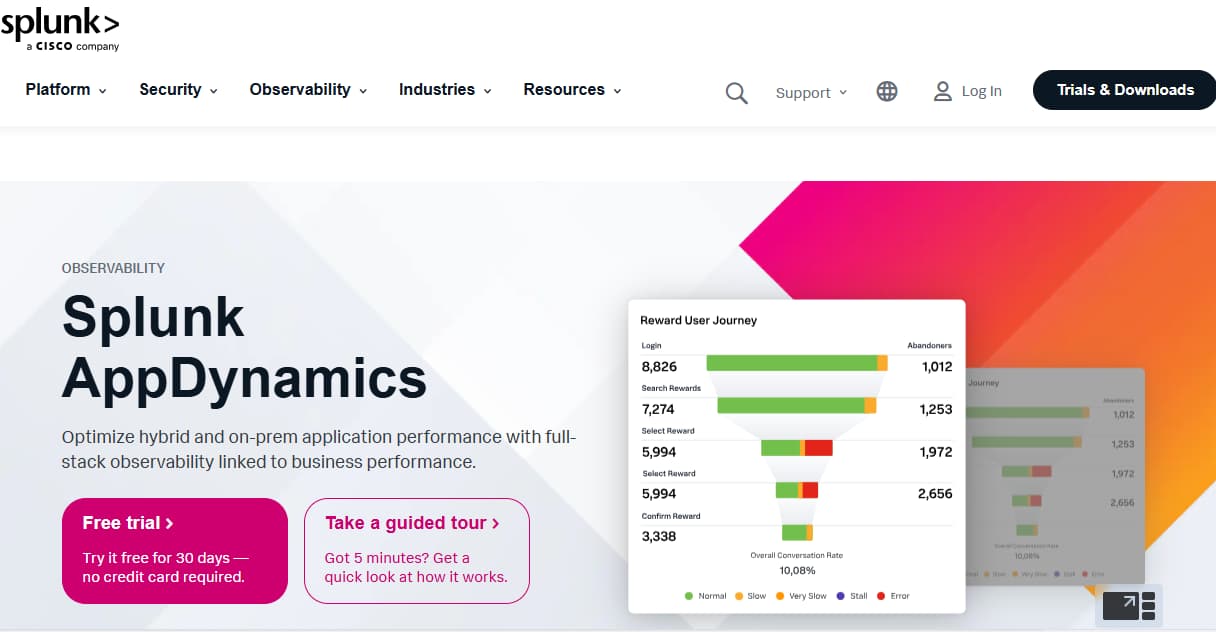
Known For
Originally developed by AppDynamics (later acquired by Cisco and now integrated under the Splunk brand), Splunk AppDynamics is a performance-driven APM platform built for enterprise workloads. It specializes in code-level diagnostics, business transaction tracing, and deep observability across hybrid, legacy, and on-prem infrastructures—making it a go-to for large, regulated industries like banking, insurance, and telecom.
Key Features
- Business Transaction Monitoring: Unlike endpoint-centric tools, AppDynamics structures observability around business transactions—e.g., “checkout,” “order processing,” or “login flow”—making it easier for engineering and business teams to align on service health.
- Deep Code-Level Diagnostics: AppDynamics provides stack traces, database call visibility, and execution timing breakdowns down to the line of code. This helps backend teams debug performance issues quickly in JVM, .NET, Node.js, PHP, and other runtimes.
- Root Cause Analysis with AI: Uses machine learning to detect performance anomalies and surface the most likely root cause—correlating metrics across application layers, dependencies, and infrastructure components.
- Hybrid Deployment Flexibility: Available in SaaS, self-hosted, or hybrid modes—AppDynamics suits enterprises with strict data residency or air-gapped requirements.
- Full-Stack Infrastructure Integration: Now part of Splunk Observability Cloud, AppDynamics offers expanded infrastructure metrics, log enrichment, and security monitoring through tighter integration with Splunk’s platform.
Standout Features
- Transaction-based observability model aligned to business workflows
- Line-level performance tracing with real-time flamegraphs
- AI-powered root cause detection
- Support for hybrid/on-prem deployments
- Common in financial services, healthcare, telecom, and government orgs
Pros
- Enterprise-ready with strong SLAs and compliance certifications
- Mature ecosystem of integrations and agent coverage
- Highly detailed stack and database visibility
- Flexible deployment (on-prem, hybrid, SaaS)
Cons
- High and unpredictable costs
- Complex setup and steep onboarding for advanced use-cases
- Inefficient alerting & maintenance overhead
Best For
- Large enterprises with legacy infrastructure or compliance constraints
- Organizations needing business-transaction-level monitoring
- Teams who prioritize performance diagnostics over MELT stack unification
- Environments where SaaS-only tools are not an option
Pricing & Customer Reviews
- APM: $33/month/CPU core
- Infrastructure Monitoring: $6/month/CPU core
- RUM: $0.06/month/1000 tokens, billed annually
- G2 Rating: 4.3 / 5
- Praised for: Deep diagnostics, deployment flexibility, business alignment
- Criticized for: High cost, Complex setup, and scaling
Splunk AppDynamics vs SigNoz
Signoz offers a modern, OTEL-first, self-hosted observability stack with basic alerting and metric support, while Splunk AppDynamics delivers detailed, transaction-focused monitoring with enterprise-grade performance insights. SigNoz is better for cloud-native teams looking for a free, open-source, and scalable telemetry backend. In contrast, AppDynamics is ideal for enterprises with complex application topologies, strict security needs, and infrastructure that spans cloud, on-prem, and legacy systems.
6. Sumo Logic

Known For
A cloud-native log management and SIEM platform with built-in APM capabilities, tailored for security-conscious organizations and DevOps teams seeking scalable log analytics.
Key Features
- Unified Log and Metrics Platform: Sumo Logic combines log management, metrics, and security analytics into one dashboard, allowing DevSecOps teams to detect anomalies, investigate issues, and automate alerts.
- Cloud-Native Architecture: Fully SaaS with multi-cloud support (AWS, Azure, GCP), enabling high-scale data ingestion and elastic compute—no infrastructure to manage.
- Flexible Query Language & Dashboards: Uses its proprietary query language (LogReduce) and real-time dashboards for customizable monitoring, suitable for engineers and security analysts alike.
Standout Features
- Built-in compliance and security analytics
- Multi-tenant SaaS deployment
- Live dashboards with alerting and anomaly detection
- Scalable ingestion with cloud-native elasticity
Pros
- No infrastructure management overhead
- Deep log analytics with live query capability
- Strong integration with Kubernetes and AWS
Cons
- Steep learning curve for advanced features and query language
- Users find Sumo Logic expensive, especially when scaling
- Delays in UI responsiveness
- Overwhelming UI for new users
Best For
- Enterprises looking for SIEM + observability in a single solution
- Teams prioritizing log analytics over trace depth
- Organizations with cloud-first architecture and no need for on-prem control
Pricing & Customer Reviews
- $3.14 estimated per TB scan
- G2 Rating: 4.2 / 5
- Praised for: Prebuilt dashboards, log depth, security integrations
- Criticized for: SaaS-only deployment, steep learning curve for queries, cost unpredictability
Sumo Logic vs SigNoz
While both tools support OpenTelemetry, SigNoz is a more OTEL-native, open-source solution whereas Sumo Logic is a cloud-based platform optimized for logs and SIEM use cases. Teams looking for open, low-cost observability may favor Signoz, but Sumo Logic is better suited to enterprises requiring combined log analytics + security posture with scalable infrastructure.
7. Better Stack

Known For
A modern, developer-centric observability platform, Better Stack specializes in log management and uptime monitoring with a beautifully designed UI. Built for startups and small teams, it emphasizes ease of use, real-time alerting, and simple setup for teams needing essential observability without the complexity of full-stack APM tools.
Key Features
- Logtail – Powerful Log Management: Centralized logging with SQL-style query capabilities and real-time tailing of logs. Built on ClickHouse, Logtail is fast and storage-efficient.
- Better Uptime – Synthetic & Incident Monitoring: Combines uptime monitoring, incident escalation, and status pages in one service—ideal for SREs and frontend-heavy monitoring use cases.
- Fully SaaS and Developer-Friendly: With no infrastructure to maintain, Better Stack is ideal for teams that want to avoid hosting complexity. Deployment typically takes minutes.
Standout Features
- Beautiful UI and intuitive log query experience
- Seamless integration with GitHub, Slack, and cloud services
- Best-in-class for synthetic checks, uptime, and incident alerts
- Low-latency log processing with ClickHouse backend
- Free plan for small teams with basic needs
Pros
- Extremely fast and easy to set up
- Clean dashboards and developer-friendly UX
- Ideal for frontend teams and uptime visibility
- Affordable pricing for small teams
Cons
- Expensive, especially for startups and smaller teams
- Missing features like outgoing webhooks
- Complex configuration
- Steep learning curve
Best For
- Startups and indie teams who want easy log aggregation + uptime monitoring
- Frontend engineers focused on incident response
- Projects without backend observability complexity
Pricing & Customer Reviews
- Free tier available for personal projects
- Logs: $0.15/GB
- Metrics: $7.50, 2TB included
- Errors: $0.000075/exception
- G2 Rating: 4.8 / 5
- Praised for: UI/UX, ease of use, speed of setup
- Criticized for: Steep learning curve, missing features, high costs especially when scaling
Better Stack vs SigNoz
Better Stack offers a radically simple, beautiful monitoring experience—but lacks the deep telemetry visibility and OTEL-first architecture of SigNoz. Teams looking for distributed tracing, metric correlation, or enterprise compliance will find Signoz more robust. Better Stack shines in simplicity, but not in full-stack observability.
Conclusion: Choosing the Right Signoz Alternative
As modern engineering teams evolve, it’s clear that while Signoz offers a solid open-source start, its production limitations—like lack of smart sampling, complex self-hosting, and performance bottlenecks—become barriers at scale. Teams are increasingly seeking alternatives that offer better cost efficiency, easier operations, and full MELT observability without sacrificing control.
Why CubeAPM Leads the Pack
Among all Signoz alternatives, CubeAPM stands out as a production-grade, OpenTelemetry-native platform designed for real-world DevOps and SRE teams. It combines blazing-fast ingestion, smart sampling, built-in dashboards, and full MELT coverage (APM, logs, infra, RUM, synthetics, error tracking) in one seamless experience—deployed in under an hour.
Whether you’re moving away from Signoz due to infrastructure overhead, scaling challenges, or gaps in full-stack coverage, CubeAPM offers a frictionless, cost-transparent, and compliance-ready observability solution that grows with your team—without locking you into complex operational trade-offs.
Disclaimer: The information in this article reflects the latest details available at the time of publication and may change as technologies and products evolve.
FAQs
1. What are the best alternatives to Signoz in 2025?
Some of the top alternatives to Signoz include CubeAPM, Datadog,and Better Stack. These platforms differ in capabilities—while CubeAPM offers OpenTelemetry-native observability with smart sampling and predictable pricing, others like Datadog and Dynatrace cater more to large enterprises with advanced AI features but at a higher cost.
2. Why are teams moving away from Signoz?
As organizations scale, they often outgrow Signoz due to its operational overhead, lack of native smart sampling, and limitations in full-stack coverage (like RUM or synthetic monitoring). Self-hosting complexity and performance bottlenecks in ClickHouse at high ingestion rates also make it harder to maintain at scale.
3. Is CubeAPM better than Signoz?
Yes—for many teams. CubeAPM offers smart sampling, built-in support for the entire MELT stack, fast ingestion, and the flexibility to self-host or go SaaS. It’s more production-ready and provides 60–80% lower TCO compared to both Signoz and legacy APM tools.
4. Is there a free alternative to Signoz?
Grafana OSS and Better Stack (free tier) are good starting points. Grafana offers strong visualization and can be combined with open-source exporters for traces and logs, while Better Stack is ideal for lightweight incident monitoring and logs. However, they may require additional setup or integrations for full observability.
5. Which Signoz alternative is best for enterprise compliance?
CubeAPM, Splunk AppDynamics, and Dynatrace are strong choices for enterprise environments. CubeAPM stands out for offering on-prem support, predictable pricing, and fine-grained data control—ideal for regulated industries.

